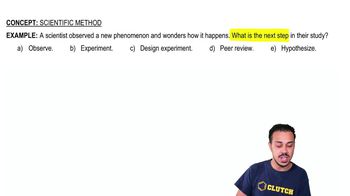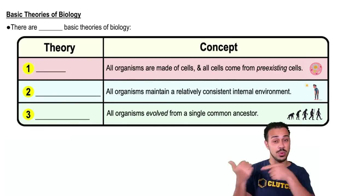Table of contents
- 1. Introduction to Biology2h 42m
- 2. Chemistry3h 40m
- 3. Water1h 26m
- 4. Biomolecules2h 23m
- 5. Cell Components2h 26m
- 6. The Membrane2h 31m
- 7. Energy and Metabolism2h 0m
- 8. Respiration2h 40m
- 9. Photosynthesis2h 49m
- 10. Cell Signaling59m
- 11. Cell Division2h 47m
- 12. Meiosis2h 0m
- 13. Mendelian Genetics4h 44m
- Introduction to Mendel's Experiments7m
- Genotype vs. Phenotype17m
- Punnett Squares13m
- Mendel's Experiments26m
- Mendel's Laws18m
- Monohybrid Crosses19m
- Test Crosses14m
- Dihybrid Crosses20m
- Punnett Square Probability26m
- Incomplete Dominance vs. Codominance20m
- Epistasis7m
- Non-Mendelian Genetics12m
- Pedigrees6m
- Autosomal Inheritance21m
- Sex-Linked Inheritance43m
- X-Inactivation9m
- 14. DNA Synthesis2h 27m
- 15. Gene Expression3h 20m
- 16. Regulation of Expression3h 31m
- Introduction to Regulation of Gene Expression13m
- Prokaryotic Gene Regulation via Operons27m
- The Lac Operon21m
- Glucose's Impact on Lac Operon25m
- The Trp Operon20m
- Review of the Lac Operon & Trp Operon11m
- Introduction to Eukaryotic Gene Regulation9m
- Eukaryotic Chromatin Modifications16m
- Eukaryotic Transcriptional Control22m
- Eukaryotic Post-Transcriptional Regulation28m
- Eukaryotic Post-Translational Regulation13m
- 17. Viruses37m
- 18. Biotechnology2h 58m
- 19. Genomics17m
- 20. Development1h 5m
- 21. Evolution3h 1m
- 22. Evolution of Populations3h 52m
- 23. Speciation1h 37m
- 24. History of Life on Earth2h 6m
- 25. Phylogeny2h 31m
- 26. Prokaryotes4h 59m
- 27. Protists1h 12m
- 28. Plants1h 22m
- 29. Fungi36m
- 30. Overview of Animals34m
- 31. Invertebrates1h 2m
- 32. Vertebrates50m
- 33. Plant Anatomy1h 3m
- 34. Vascular Plant Transport1h 2m
- 35. Soil37m
- 36. Plant Reproduction47m
- 37. Plant Sensation and Response1h 9m
- 38. Animal Form and Function1h 19m
- 39. Digestive System1h 10m
- 40. Circulatory System1h 57m
- 41. Immune System1h 12m
- 42. Osmoregulation and Excretion50m
- 43. Endocrine System1h 4m
- 44. Animal Reproduction1h 2m
- 45. Nervous System1h 55m
- 46. Sensory Systems46m
- 47. Muscle Systems23m
- 48. Ecology3h 11m
- Introduction to Ecology20m
- Biogeography14m
- Earth's Climate Patterns50m
- Introduction to Terrestrial Biomes10m
- Terrestrial Biomes: Near Equator13m
- Terrestrial Biomes: Temperate Regions10m
- Terrestrial Biomes: Northern Regions15m
- Introduction to Aquatic Biomes27m
- Freshwater Aquatic Biomes14m
- Marine Aquatic Biomes13m
- 49. Animal Behavior28m
- 50. Population Ecology3h 41m
- Introduction to Population Ecology28m
- Population Sampling Methods23m
- Life History12m
- Population Demography17m
- Factors Limiting Population Growth14m
- Introduction to Population Growth Models22m
- Linear Population Growth6m
- Exponential Population Growth29m
- Logistic Population Growth32m
- r/K Selection10m
- The Human Population22m
- 51. Community Ecology2h 46m
- Introduction to Community Ecology2m
- Introduction to Community Interactions9m
- Community Interactions: Competition (-/-)38m
- Community Interactions: Exploitation (+/-)23m
- Community Interactions: Mutualism (+/+) & Commensalism (+/0)9m
- Community Structure35m
- Community Dynamics26m
- Geographic Impact on Communities21m
- 52. Ecosystems2h 36m
- 53. Conservation Biology24m
1. Introduction to Biology
Scientific Method
Problem 4a`
Textbook Question
In science, a theory is a(n)
a. Educated guess
b. Inference based on a lack of scientific evidence
c. Idea with little experimental support
d. Body of scientifically acceptable general principles
e. Statement of fact
 Verified step by step guidance
Verified step by step guidance1
Step 1: Begin by understanding the definition of a scientific theory. In science, a theory is not a mere guess or unsupported idea; it is a well-substantiated explanation of some aspect of the natural world.
Step 2: Recognize that scientific theories are based on a body of evidence collected through observation, experimentation, and analysis. They are supported by repeated testing and are widely accepted within the scientific community.
Step 3: Eliminate options that do not align with the rigorous nature of scientific theories. For example, options like 'educated guess' or 'idea with little experimental support' do not reflect the depth of evidence required for a scientific theory.
Step 4: Consider the role of scientific principles in forming a theory. A theory often integrates and explains a set of scientifically acceptable general principles that help predict and understand phenomena.
Step 5: Based on the above reasoning, identify the correct option that aligns with the definition of a scientific theory: 'a body of scientifically acceptable general principles.'
 Verified video answer for a similar problem:
Verified video answer for a similar problem:This video solution was recommended by our tutors as helpful for the problem above
Video duration:
38sPlay a video:
Was this helpful?
Key Concepts
Here are the essential concepts you must grasp in order to answer the question correctly.
Scientific Theory
A scientific theory is a well-substantiated explanation of some aspect of the natural world, based on a body of evidence and repeated testing. It is not merely a guess or hypothesis; rather, it integrates and generalizes many observations and experimental results. Theories can evolve over time as new evidence emerges, but they remain robust frameworks for understanding phenomena.
Recommended video:
Guided course

Scientific Method
Hypothesis vs. Theory
A hypothesis is a testable prediction or educated guess that can be investigated through experimentation, while a theory is a comprehensive explanation that has been validated through extensive research and evidence. Understanding the distinction between these two concepts is crucial, as it highlights the progression from initial ideas to well-supported scientific conclusions.
Recommended video:
Guided course

Predictions, Hypotheses, & Theories
Scientific Evidence
Scientific evidence refers to the data and observations collected through experiments and research that support or refute a theory or hypothesis. This evidence must be reproducible and peer-reviewed to be considered credible. The strength of a scientific theory is often determined by the amount and quality of evidence backing it, making evidence a cornerstone of scientific inquiry.
Recommended video:
Guided course

Scientific Method
Related Videos
Related Practice












